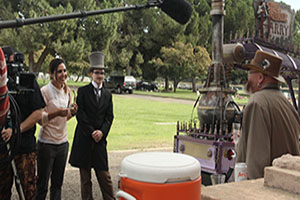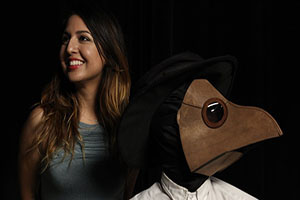Cinematic Arts Student Directs a Documentary on Steampunk

On Friday, Dec. 12, a documentary, created by USC students and depicting an interesting Victorian subculture called Steampunk will be aired at USC.
Steampunk is a subculture filled with the retro style of the Victorian era. At the same time, the culture also reaches toward more mechanical and futuristic themes. Steampunk had caught the attention of Mischa Cantu, a second year graduate student at the School of Cinematic Arts at USC.
“I guess the definition of Steampunk would be a tech driven, retro-futuristic, Victorian-inspired aesthetic,” she said.
Cantu was a director of a documentary called “Steam Dream.” The 18 minute piece introduces viewers to people who participate in the Steampunk subculture.
SEE ALSO: What is Steampunk? A Subculture Infiltrating Films, Music, Fashion, More
Cantu’s interest in Steampunk culture started in her childhood. Her mother, who has a degree in creative writing from the University of Arizona, gave Cantu books instead of toys. Through the Great Illustrated Classics series, Cantu fell in love with Victorian books like “The Picture of Dorian Gray” and the works of Jules Verne and Thomas Mann.
“Later on, I come to find out that there’s actually people that want to relive that kind of adventure, that pre-industrial excitement,” Cantu said. “I found out in undergrad that it was called ‘Steampunk,’ I was kind put off by the punk part, but that just means reimagining the past,”
Cantu took a class that required students to pitch an idea for a documentary last spring. At the end of the semester, all of the students in the class presented their idea to an auditorium of professors and peers. The audience then decided what idea would go into production.
“We made a small, five minute sampling,” said Cantu, “I had gone to some Steampunk events and interviewed people that I knew that were into Steampunk and put together a teaser-trailer.”
Cantu was one of three students chosen out of 10 to direct a documentary. The next task was to gather students at the school of Cinematic Arts to help create the film. The group entailed one director of photography, two producers, two sound recorders, and two editors.
“When I was picked, I was given the privilege of choosing my crew among students in the graduate program,” Cantu said.
Originally, the group planned to explore the concept of the subculture, but then changed it to be a piece about the individuals that participate in Steampunk. Cantu aimed to discover why people indulged in what she calls a “false nostalgia.”
“It’s not really the way Victorian era was when you have the Steampunk goggles and the gears,” said Cantu. “We wanted to see what really is at the root of why these people do it and typically it’s escapism.”

According to Cantu, some people participate in Steampunk because they feel others mistreat and ostracize them. This was a topic the group realized while filmmaking, according to Cantu.
“They feel they’ve been bullied or they feel that in their everyday life they’re being judged,” she said. “So they want to create this other character who embodies the kind of refinement or dignity that they’re chasing after.”
Steampunk culture can come in different categories. Some people are “cosplayers” who wear costumes to events. Some people are “makers” and create Steampunk related objects, according to Cantu. Researching via the internet led her to Ave Rose, who creates Steampunk related taxidermy.
“She has this site that has all of these awesome taxidermy steampunk creations that she’s made that’s super intricate and exquisite,” Cantu said. Rose builds mechanical creations that move; she sells her creations on Esty, an online marketplace of homemade goods. “Approaching it from [a viewpoint] other than cosplay allowed us to show a wider array because there’s those purist Steampunks or gothic Steampunks. There’s a lot of different kinds.”
Most of the filming took place during Saturdays and Sundays. They filmed for up to six hours each day, according to Cantu. In order to do research, she attended several different Steampunk events, including a tea party in a cemetery.
“They were saying that in the Victoria era people would often have picnics in cemeteries and that’s why they’re made to look like parks and so why not continue with that kind of tradition.” said Cantu.
At Steampunk events, Cantu dressed up as a character she created from Alex McDowell’s world building project in order to relate to participants. Her tactics to recruit subjects for the documentary must vary; no single approach works for every person, according Cantu.
“To make them feel like they can open up is the hard goal,” she said. “With each person, the approach has to be different. Sometimes you don’t realize the delicacy that’s needed.”
SEE MORE: Imagining Worlds Class Talk About World Building Exhibit
Filming a documentary was a different practice for Cantu and her crew. They have more experience with producing on sound stages; lacking that control over the scene they are recording was a challenge, according to Cantu.

“We’re used to being on stages where you have time to set up lights,” said Cantu, “Now in documentary, we have to go and be ready for anything and not talk because something might happen. It’s a whole other world and it’s difficult.”
A major lesson Cantu took from producing the documentary was the importance of collaboration. Steampunk participants have an affinity with clock gears and see themselves as gears interworking with each other. It symbolizes how people always have a place in society, according to Cantu.
“Feeling like you do have this place and ability to feel secure and control in your life is really quite beautiful,” she said. “not feeling things are out of your hands.”
Cantu has much pride in “Steam Dream,” saying that it is the best film that she created.
“Filmmaking is kind of like Alchemy,” said Cantu. “You brew it, stir it up and hopefully the elixir is exquisite.”
Reach Staff Reporter Amanda Scurlock here. Follow her on Twitter here.



